Policy Brief: Prenatal Alcohol Exposure and Fetal Alcohol Spectrum
VerifiedAdded on 2022/11/09
|9
|2412
|97
AI Summary
This policy brief addresses the critical issue of prenatal alcohol exposure (PAE) and Fetal Alcohol Spectrum Disorder (FASD) in Victoria, Australia, highlighting the urgent need for policy intervention. The brief outlines the increasing prevalence of PAE and FASD, marked by social, emotional, cognitive, and developmental challenges in affected children. It emphasizes the limited awareness and education surrounding these issues in Australia, leading to delayed diagnosis, societal stigma, and adverse health outcomes. Factors contributing to the high prevalence include low education levels, low incomes, unhealthy social relationships, and genetic predispositions. The brief recommends policies to enhance awareness among healthcare providers and the community, alongside mandatory screening, diagnosis, and treatment for at-risk populations and newborns. Ultimately, the brief advocates for proactive measures to prevent PAE, improve public health outcomes, and streamline screening and treatment policies to mitigate the long-term consequences of FASD, including potential involvement in criminal activities and mental health issues. Desklib offers a variety of resources for students, including solved assignments and past papers.
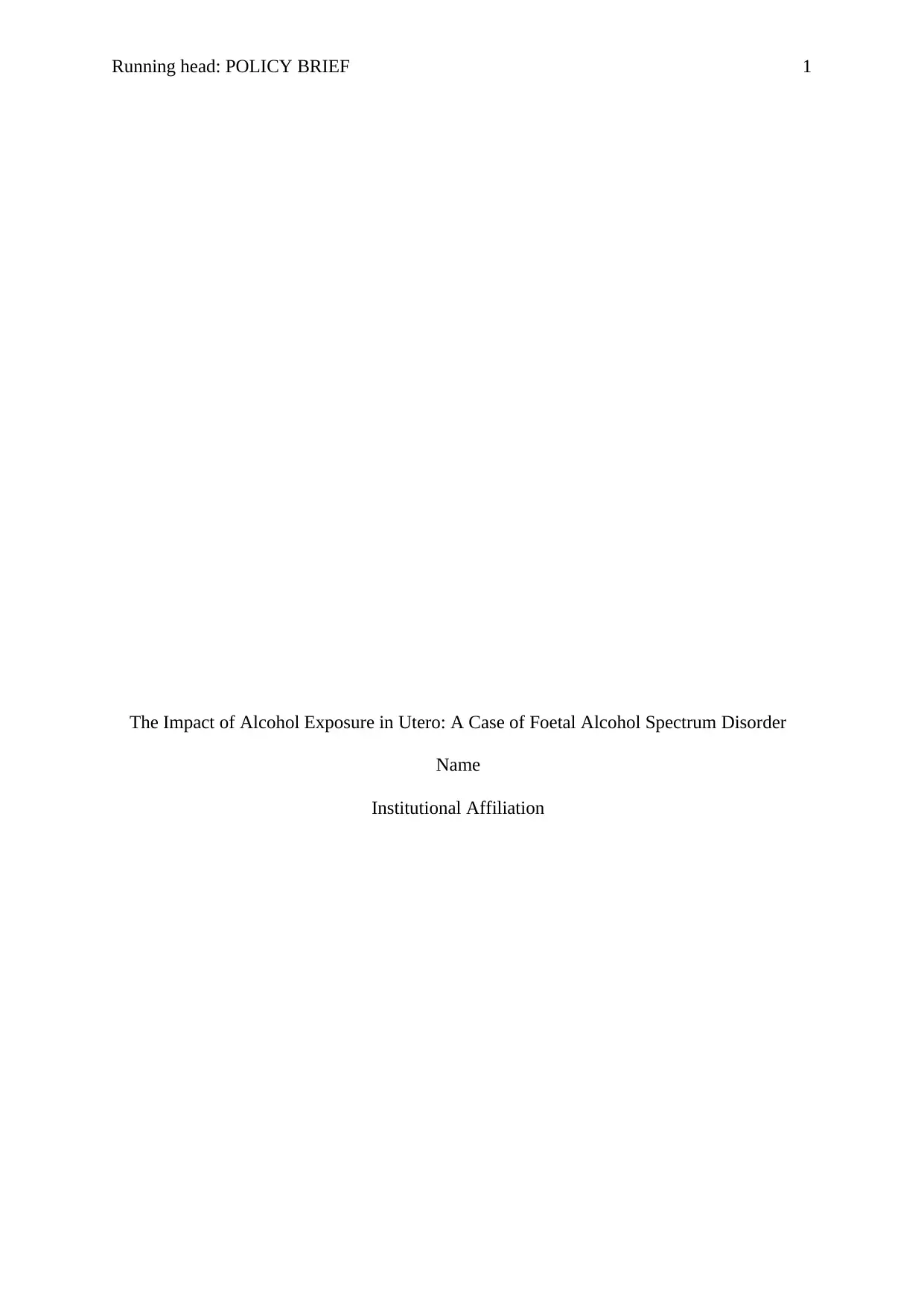
Running head: POLICY BRIEF 1
The Impact of Alcohol Exposure in Utero: A Case of Foetal Alcohol Spectrum Disorder
Name
Institutional Affiliation
The Impact of Alcohol Exposure in Utero: A Case of Foetal Alcohol Spectrum Disorder
Name
Institutional Affiliation
Paraphrase This Document
Need a fresh take? Get an instant paraphrase of this document with our AI Paraphraser
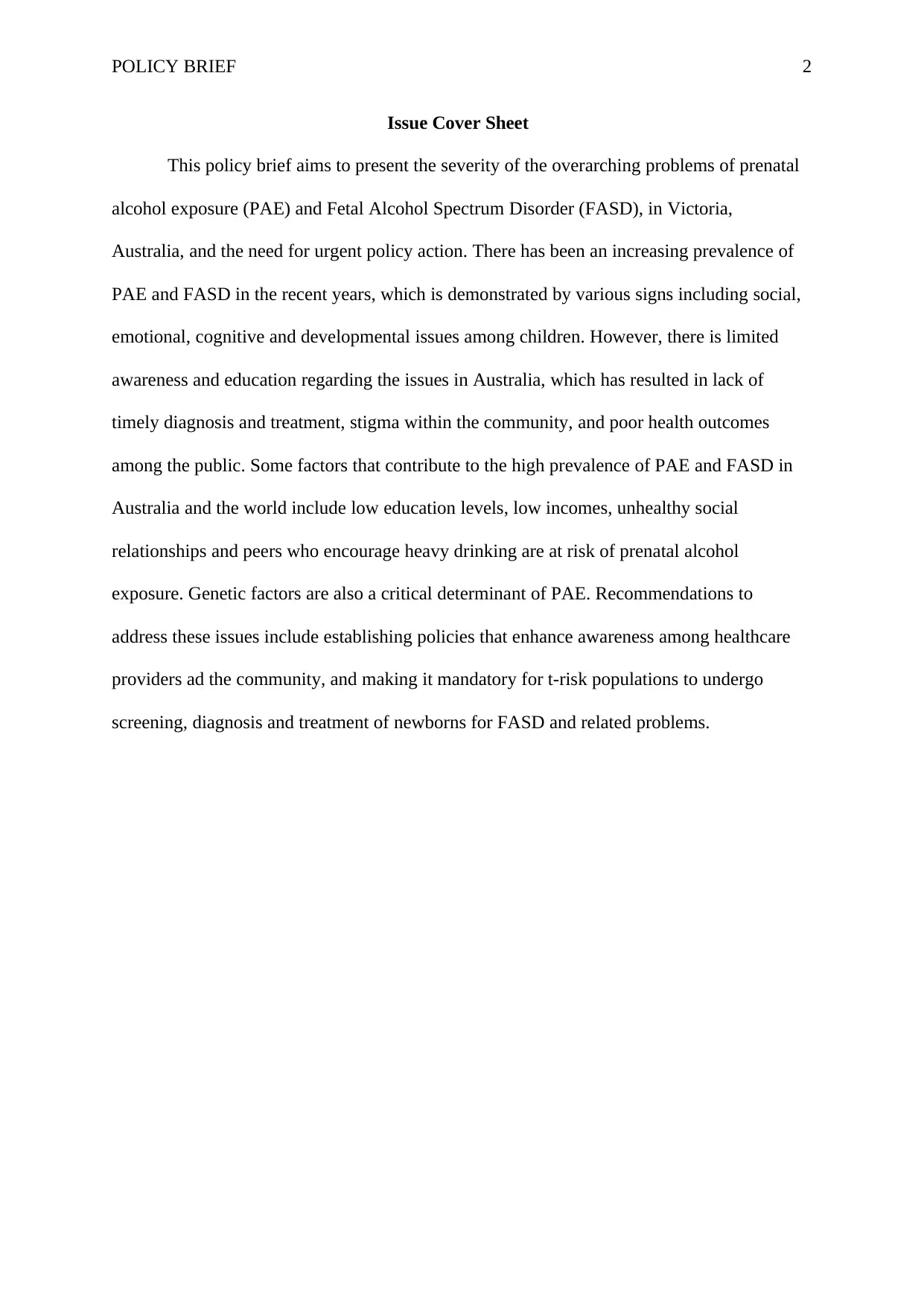
POLICY BRIEF 2
Issue Cover Sheet
This policy brief aims to present the severity of the overarching problems of prenatal
alcohol exposure (PAE) and Fetal Alcohol Spectrum Disorder (FASD), in Victoria,
Australia, and the need for urgent policy action. There has been an increasing prevalence of
PAE and FASD in the recent years, which is demonstrated by various signs including social,
emotional, cognitive and developmental issues among children. However, there is limited
awareness and education regarding the issues in Australia, which has resulted in lack of
timely diagnosis and treatment, stigma within the community, and poor health outcomes
among the public. Some factors that contribute to the high prevalence of PAE and FASD in
Australia and the world include low education levels, low incomes, unhealthy social
relationships and peers who encourage heavy drinking are at risk of prenatal alcohol
exposure. Genetic factors are also a critical determinant of PAE. Recommendations to
address these issues include establishing policies that enhance awareness among healthcare
providers ad the community, and making it mandatory for t-risk populations to undergo
screening, diagnosis and treatment of newborns for FASD and related problems.
Issue Cover Sheet
This policy brief aims to present the severity of the overarching problems of prenatal
alcohol exposure (PAE) and Fetal Alcohol Spectrum Disorder (FASD), in Victoria,
Australia, and the need for urgent policy action. There has been an increasing prevalence of
PAE and FASD in the recent years, which is demonstrated by various signs including social,
emotional, cognitive and developmental issues among children. However, there is limited
awareness and education regarding the issues in Australia, which has resulted in lack of
timely diagnosis and treatment, stigma within the community, and poor health outcomes
among the public. Some factors that contribute to the high prevalence of PAE and FASD in
Australia and the world include low education levels, low incomes, unhealthy social
relationships and peers who encourage heavy drinking are at risk of prenatal alcohol
exposure. Genetic factors are also a critical determinant of PAE. Recommendations to
address these issues include establishing policies that enhance awareness among healthcare
providers ad the community, and making it mandatory for t-risk populations to undergo
screening, diagnosis and treatment of newborns for FASD and related problems.
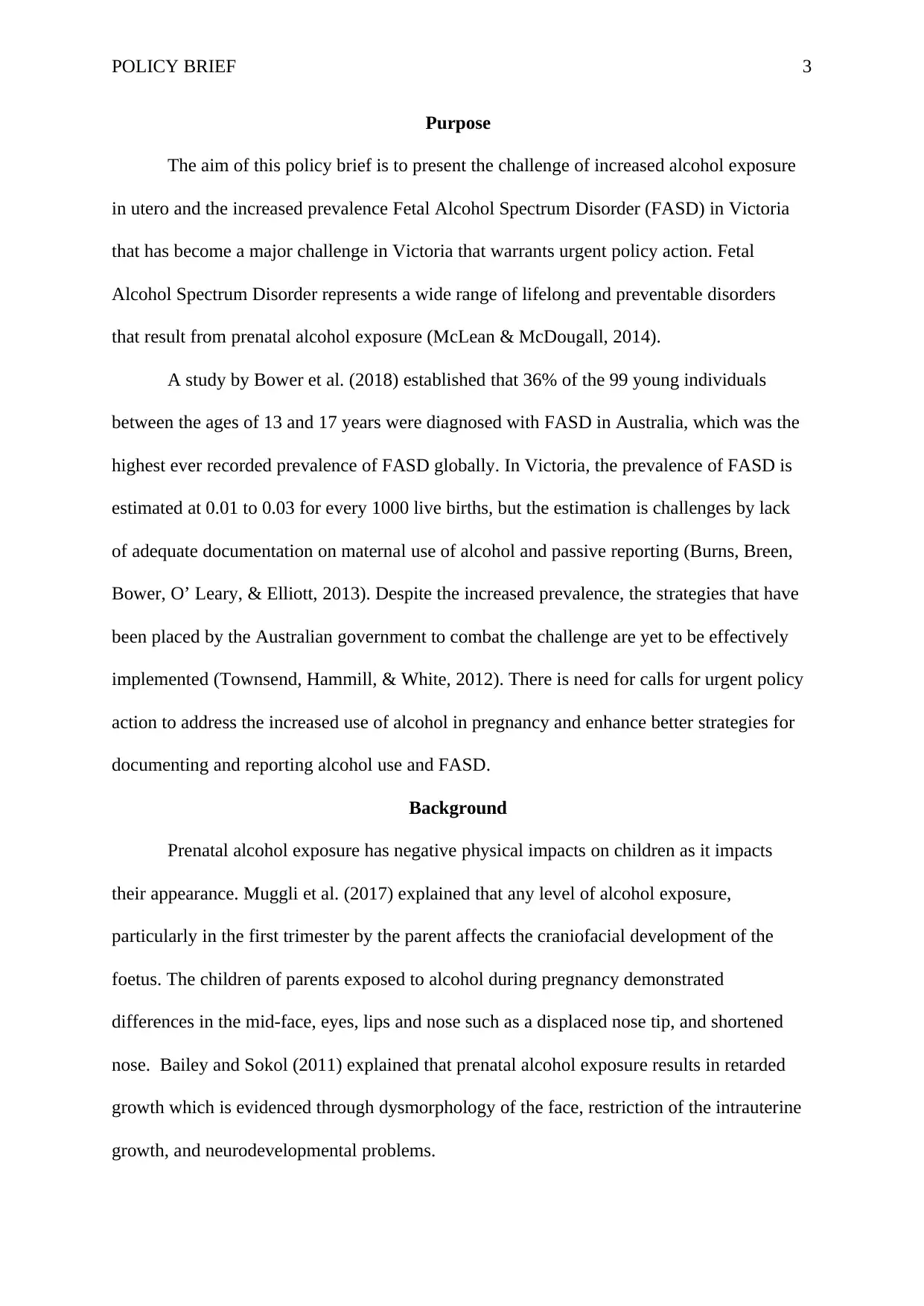
POLICY BRIEF 3
Purpose
The aim of this policy brief is to present the challenge of increased alcohol exposure
in utero and the increased prevalence Fetal Alcohol Spectrum Disorder (FASD) in Victoria
that has become a major challenge in Victoria that warrants urgent policy action. Fetal
Alcohol Spectrum Disorder represents a wide range of lifelong and preventable disorders
that result from prenatal alcohol exposure (McLean & McDougall, 2014).
A study by Bower et al. (2018) established that 36% of the 99 young individuals
between the ages of 13 and 17 years were diagnosed with FASD in Australia, which was the
highest ever recorded prevalence of FASD globally. In Victoria, the prevalence of FASD is
estimated at 0.01 to 0.03 for every 1000 live births, but the estimation is challenges by lack
of adequate documentation on maternal use of alcohol and passive reporting (Burns, Breen,
Bower, O’ Leary, & Elliott, 2013). Despite the increased prevalence, the strategies that have
been placed by the Australian government to combat the challenge are yet to be effectively
implemented (Townsend, Hammill, & White, 2012). There is need for calls for urgent policy
action to address the increased use of alcohol in pregnancy and enhance better strategies for
documenting and reporting alcohol use and FASD.
Background
Prenatal alcohol exposure has negative physical impacts on children as it impacts
their appearance. Muggli et al. (2017) explained that any level of alcohol exposure,
particularly in the first trimester by the parent affects the craniofacial development of the
foetus. The children of parents exposed to alcohol during pregnancy demonstrated
differences in the mid-face, eyes, lips and nose such as a displaced nose tip, and shortened
nose. Bailey and Sokol (2011) explained that prenatal alcohol exposure results in retarded
growth which is evidenced through dysmorphology of the face, restriction of the intrauterine
growth, and neurodevelopmental problems.
Purpose
The aim of this policy brief is to present the challenge of increased alcohol exposure
in utero and the increased prevalence Fetal Alcohol Spectrum Disorder (FASD) in Victoria
that has become a major challenge in Victoria that warrants urgent policy action. Fetal
Alcohol Spectrum Disorder represents a wide range of lifelong and preventable disorders
that result from prenatal alcohol exposure (McLean & McDougall, 2014).
A study by Bower et al. (2018) established that 36% of the 99 young individuals
between the ages of 13 and 17 years were diagnosed with FASD in Australia, which was the
highest ever recorded prevalence of FASD globally. In Victoria, the prevalence of FASD is
estimated at 0.01 to 0.03 for every 1000 live births, but the estimation is challenges by lack
of adequate documentation on maternal use of alcohol and passive reporting (Burns, Breen,
Bower, O’ Leary, & Elliott, 2013). Despite the increased prevalence, the strategies that have
been placed by the Australian government to combat the challenge are yet to be effectively
implemented (Townsend, Hammill, & White, 2012). There is need for calls for urgent policy
action to address the increased use of alcohol in pregnancy and enhance better strategies for
documenting and reporting alcohol use and FASD.
Background
Prenatal alcohol exposure has negative physical impacts on children as it impacts
their appearance. Muggli et al. (2017) explained that any level of alcohol exposure,
particularly in the first trimester by the parent affects the craniofacial development of the
foetus. The children of parents exposed to alcohol during pregnancy demonstrated
differences in the mid-face, eyes, lips and nose such as a displaced nose tip, and shortened
nose. Bailey and Sokol (2011) explained that prenatal alcohol exposure results in retarded
growth which is evidenced through dysmorphology of the face, restriction of the intrauterine
growth, and neurodevelopmental problems.
⊘ This is a preview!⊘
Do you want full access?
Subscribe today to unlock all pages.

Trusted by 1+ million students worldwide
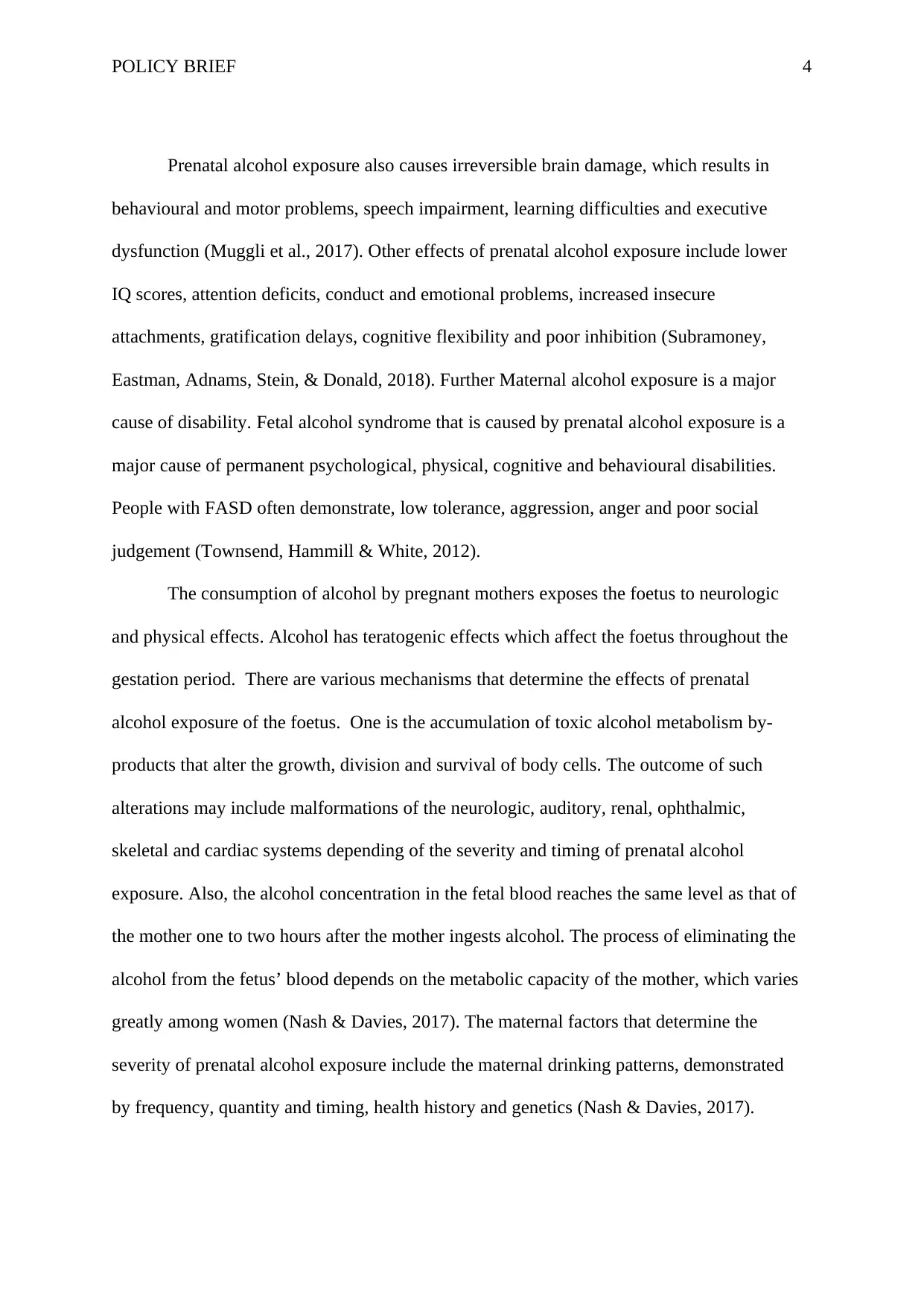
POLICY BRIEF 4
Prenatal alcohol exposure also causes irreversible brain damage, which results in
behavioural and motor problems, speech impairment, learning difficulties and executive
dysfunction (Muggli et al., 2017). Other effects of prenatal alcohol exposure include lower
IQ scores, attention deficits, conduct and emotional problems, increased insecure
attachments, gratification delays, cognitive flexibility and poor inhibition (Subramoney,
Eastman, Adnams, Stein, & Donald, 2018). Further Maternal alcohol exposure is a major
cause of disability. Fetal alcohol syndrome that is caused by prenatal alcohol exposure is a
major cause of permanent psychological, physical, cognitive and behavioural disabilities.
People with FASD often demonstrate, low tolerance, aggression, anger and poor social
judgement (Townsend, Hammill & White, 2012).
The consumption of alcohol by pregnant mothers exposes the foetus to neurologic
and physical effects. Alcohol has teratogenic effects which affect the foetus throughout the
gestation period. There are various mechanisms that determine the effects of prenatal
alcohol exposure of the foetus. One is the accumulation of toxic alcohol metabolism by-
products that alter the growth, division and survival of body cells. The outcome of such
alterations may include malformations of the neurologic, auditory, renal, ophthalmic,
skeletal and cardiac systems depending of the severity and timing of prenatal alcohol
exposure. Also, the alcohol concentration in the fetal blood reaches the same level as that of
the mother one to two hours after the mother ingests alcohol. The process of eliminating the
alcohol from the fetus’ blood depends on the metabolic capacity of the mother, which varies
greatly among women (Nash & Davies, 2017). The maternal factors that determine the
severity of prenatal alcohol exposure include the maternal drinking patterns, demonstrated
by frequency, quantity and timing, health history and genetics (Nash & Davies, 2017).
Prenatal alcohol exposure also causes irreversible brain damage, which results in
behavioural and motor problems, speech impairment, learning difficulties and executive
dysfunction (Muggli et al., 2017). Other effects of prenatal alcohol exposure include lower
IQ scores, attention deficits, conduct and emotional problems, increased insecure
attachments, gratification delays, cognitive flexibility and poor inhibition (Subramoney,
Eastman, Adnams, Stein, & Donald, 2018). Further Maternal alcohol exposure is a major
cause of disability. Fetal alcohol syndrome that is caused by prenatal alcohol exposure is a
major cause of permanent psychological, physical, cognitive and behavioural disabilities.
People with FASD often demonstrate, low tolerance, aggression, anger and poor social
judgement (Townsend, Hammill & White, 2012).
The consumption of alcohol by pregnant mothers exposes the foetus to neurologic
and physical effects. Alcohol has teratogenic effects which affect the foetus throughout the
gestation period. There are various mechanisms that determine the effects of prenatal
alcohol exposure of the foetus. One is the accumulation of toxic alcohol metabolism by-
products that alter the growth, division and survival of body cells. The outcome of such
alterations may include malformations of the neurologic, auditory, renal, ophthalmic,
skeletal and cardiac systems depending of the severity and timing of prenatal alcohol
exposure. Also, the alcohol concentration in the fetal blood reaches the same level as that of
the mother one to two hours after the mother ingests alcohol. The process of eliminating the
alcohol from the fetus’ blood depends on the metabolic capacity of the mother, which varies
greatly among women (Nash & Davies, 2017). The maternal factors that determine the
severity of prenatal alcohol exposure include the maternal drinking patterns, demonstrated
by frequency, quantity and timing, health history and genetics (Nash & Davies, 2017).
Paraphrase This Document
Need a fresh take? Get an instant paraphrase of this document with our AI Paraphraser
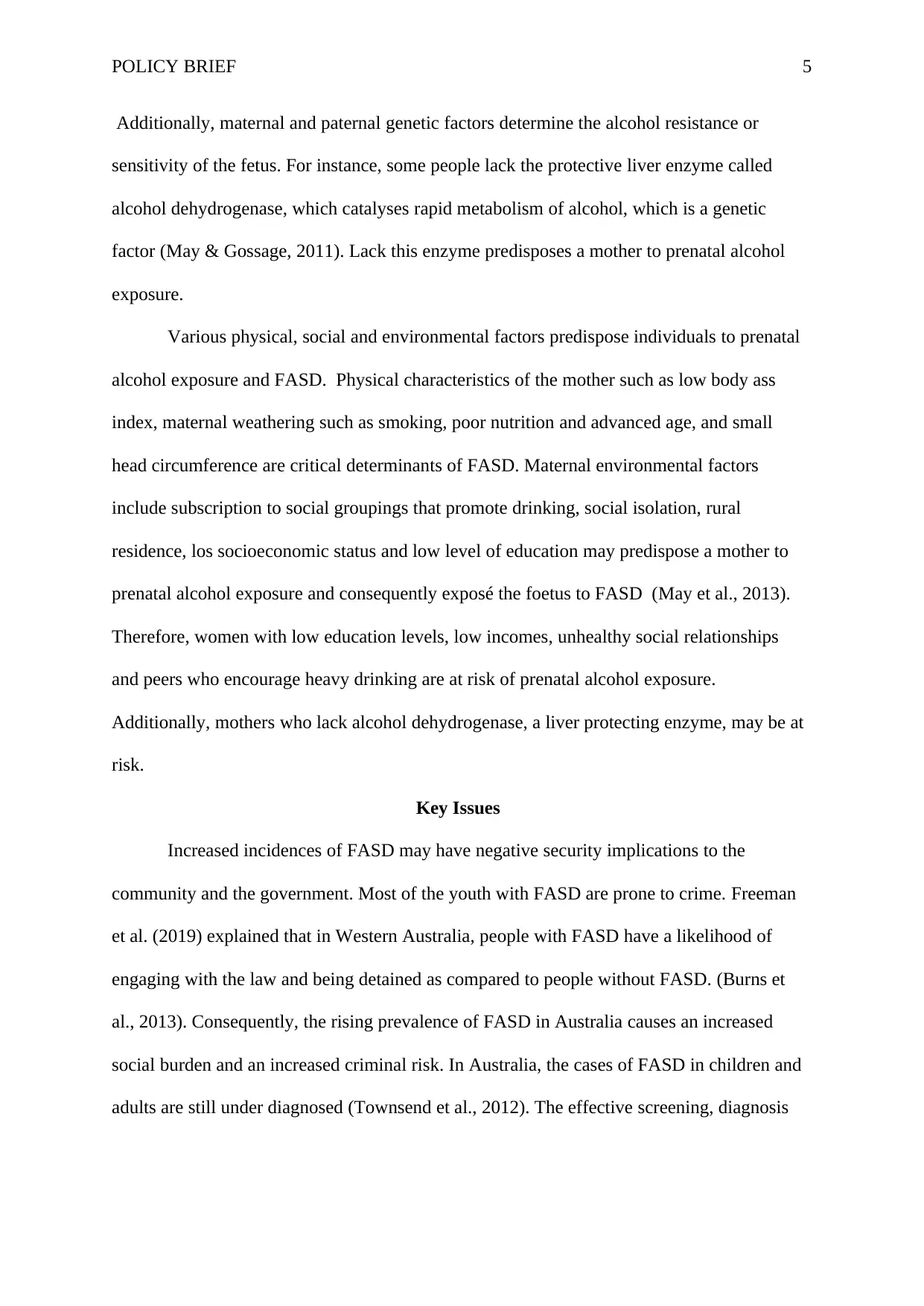
POLICY BRIEF 5
Additionally, maternal and paternal genetic factors determine the alcohol resistance or
sensitivity of the fetus. For instance, some people lack the protective liver enzyme called
alcohol dehydrogenase, which catalyses rapid metabolism of alcohol, which is a genetic
factor (May & Gossage, 2011). Lack this enzyme predisposes a mother to prenatal alcohol
exposure.
Various physical, social and environmental factors predispose individuals to prenatal
alcohol exposure and FASD. Physical characteristics of the mother such as low body ass
index, maternal weathering such as smoking, poor nutrition and advanced age, and small
head circumference are critical determinants of FASD. Maternal environmental factors
include subscription to social groupings that promote drinking, social isolation, rural
residence, los socioeconomic status and low level of education may predispose a mother to
prenatal alcohol exposure and consequently exposé the foetus to FASD (May et al., 2013).
Therefore, women with low education levels, low incomes, unhealthy social relationships
and peers who encourage heavy drinking are at risk of prenatal alcohol exposure.
Additionally, mothers who lack alcohol dehydrogenase, a liver protecting enzyme, may be at
risk.
Key Issues
Increased incidences of FASD may have negative security implications to the
community and the government. Most of the youth with FASD are prone to crime. Freeman
et al. (2019) explained that in Western Australia, people with FASD have a likelihood of
engaging with the law and being detained as compared to people without FASD. (Burns et
al., 2013). Consequently, the rising prevalence of FASD in Australia causes an increased
social burden and an increased criminal risk. In Australia, the cases of FASD in children and
adults are still under diagnosed (Townsend et al., 2012). The effective screening, diagnosis
Additionally, maternal and paternal genetic factors determine the alcohol resistance or
sensitivity of the fetus. For instance, some people lack the protective liver enzyme called
alcohol dehydrogenase, which catalyses rapid metabolism of alcohol, which is a genetic
factor (May & Gossage, 2011). Lack this enzyme predisposes a mother to prenatal alcohol
exposure.
Various physical, social and environmental factors predispose individuals to prenatal
alcohol exposure and FASD. Physical characteristics of the mother such as low body ass
index, maternal weathering such as smoking, poor nutrition and advanced age, and small
head circumference are critical determinants of FASD. Maternal environmental factors
include subscription to social groupings that promote drinking, social isolation, rural
residence, los socioeconomic status and low level of education may predispose a mother to
prenatal alcohol exposure and consequently exposé the foetus to FASD (May et al., 2013).
Therefore, women with low education levels, low incomes, unhealthy social relationships
and peers who encourage heavy drinking are at risk of prenatal alcohol exposure.
Additionally, mothers who lack alcohol dehydrogenase, a liver protecting enzyme, may be at
risk.
Key Issues
Increased incidences of FASD may have negative security implications to the
community and the government. Most of the youth with FASD are prone to crime. Freeman
et al. (2019) explained that in Western Australia, people with FASD have a likelihood of
engaging with the law and being detained as compared to people without FASD. (Burns et
al., 2013). Consequently, the rising prevalence of FASD in Australia causes an increased
social burden and an increased criminal risk. In Australia, the cases of FASD in children and
adults are still under diagnosed (Townsend et al., 2012). The effective screening, diagnosis
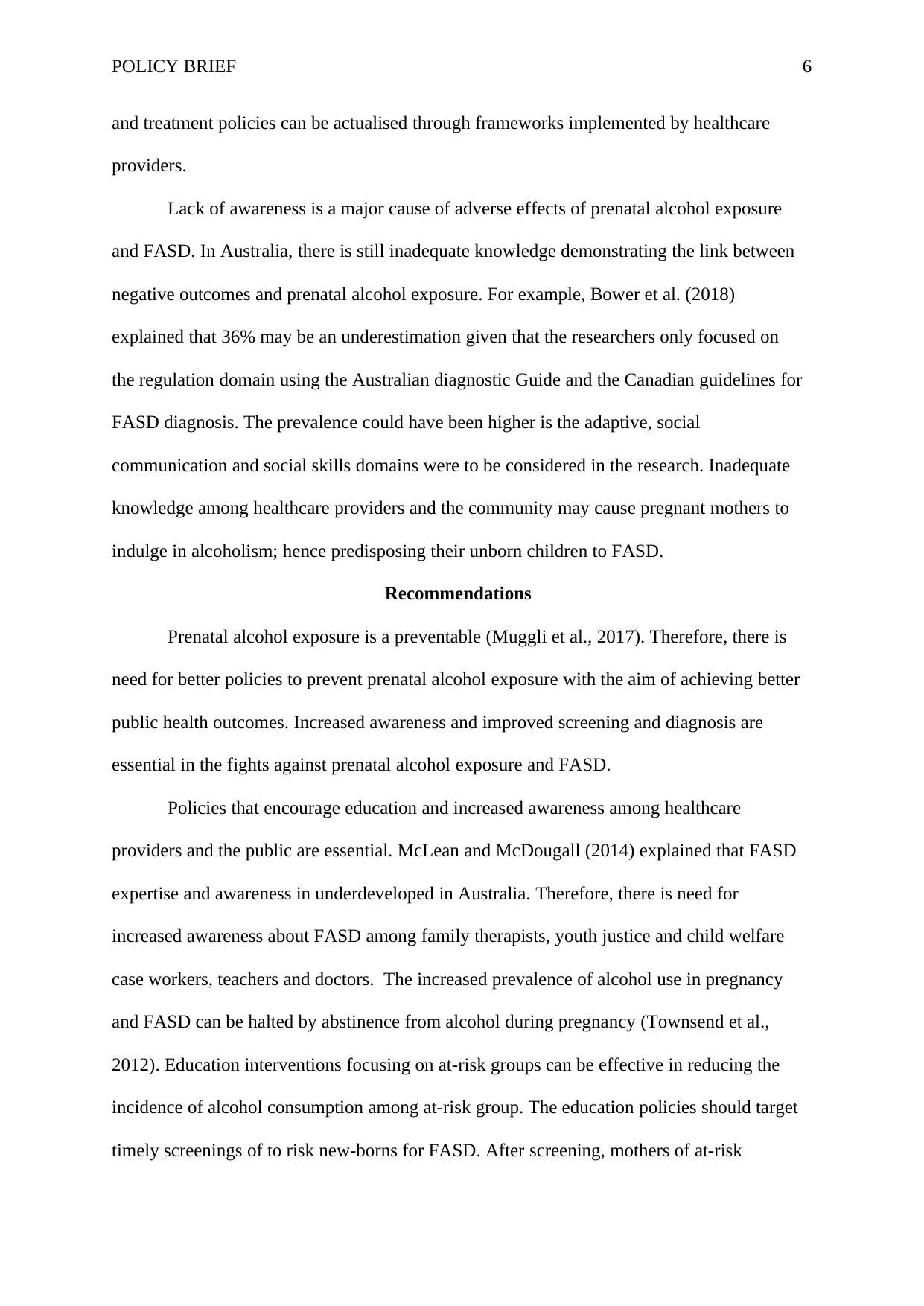
POLICY BRIEF 6
and treatment policies can be actualised through frameworks implemented by healthcare
providers.
Lack of awareness is a major cause of adverse effects of prenatal alcohol exposure
and FASD. In Australia, there is still inadequate knowledge demonstrating the link between
negative outcomes and prenatal alcohol exposure. For example, Bower et al. (2018)
explained that 36% may be an underestimation given that the researchers only focused on
the regulation domain using the Australian diagnostic Guide and the Canadian guidelines for
FASD diagnosis. The prevalence could have been higher is the adaptive, social
communication and social skills domains were to be considered in the research. Inadequate
knowledge among healthcare providers and the community may cause pregnant mothers to
indulge in alcoholism; hence predisposing their unborn children to FASD.
Recommendations
Prenatal alcohol exposure is a preventable (Muggli et al., 2017). Therefore, there is
need for better policies to prevent prenatal alcohol exposure with the aim of achieving better
public health outcomes. Increased awareness and improved screening and diagnosis are
essential in the fights against prenatal alcohol exposure and FASD.
Policies that encourage education and increased awareness among healthcare
providers and the public are essential. McLean and McDougall (2014) explained that FASD
expertise and awareness in underdeveloped in Australia. Therefore, there is need for
increased awareness about FASD among family therapists, youth justice and child welfare
case workers, teachers and doctors. The increased prevalence of alcohol use in pregnancy
and FASD can be halted by abstinence from alcohol during pregnancy (Townsend et al.,
2012). Education interventions focusing on at-risk groups can be effective in reducing the
incidence of alcohol consumption among at-risk group. The education policies should target
timely screenings of to risk new-borns for FASD. After screening, mothers of at-risk
and treatment policies can be actualised through frameworks implemented by healthcare
providers.
Lack of awareness is a major cause of adverse effects of prenatal alcohol exposure
and FASD. In Australia, there is still inadequate knowledge demonstrating the link between
negative outcomes and prenatal alcohol exposure. For example, Bower et al. (2018)
explained that 36% may be an underestimation given that the researchers only focused on
the regulation domain using the Australian diagnostic Guide and the Canadian guidelines for
FASD diagnosis. The prevalence could have been higher is the adaptive, social
communication and social skills domains were to be considered in the research. Inadequate
knowledge among healthcare providers and the community may cause pregnant mothers to
indulge in alcoholism; hence predisposing their unborn children to FASD.
Recommendations
Prenatal alcohol exposure is a preventable (Muggli et al., 2017). Therefore, there is
need for better policies to prevent prenatal alcohol exposure with the aim of achieving better
public health outcomes. Increased awareness and improved screening and diagnosis are
essential in the fights against prenatal alcohol exposure and FASD.
Policies that encourage education and increased awareness among healthcare
providers and the public are essential. McLean and McDougall (2014) explained that FASD
expertise and awareness in underdeveloped in Australia. Therefore, there is need for
increased awareness about FASD among family therapists, youth justice and child welfare
case workers, teachers and doctors. The increased prevalence of alcohol use in pregnancy
and FASD can be halted by abstinence from alcohol during pregnancy (Townsend et al.,
2012). Education interventions focusing on at-risk groups can be effective in reducing the
incidence of alcohol consumption among at-risk group. The education policies should target
timely screenings of to risk new-borns for FASD. After screening, mothers of at-risk
⊘ This is a preview!⊘
Do you want full access?
Subscribe today to unlock all pages.

Trusted by 1+ million students worldwide
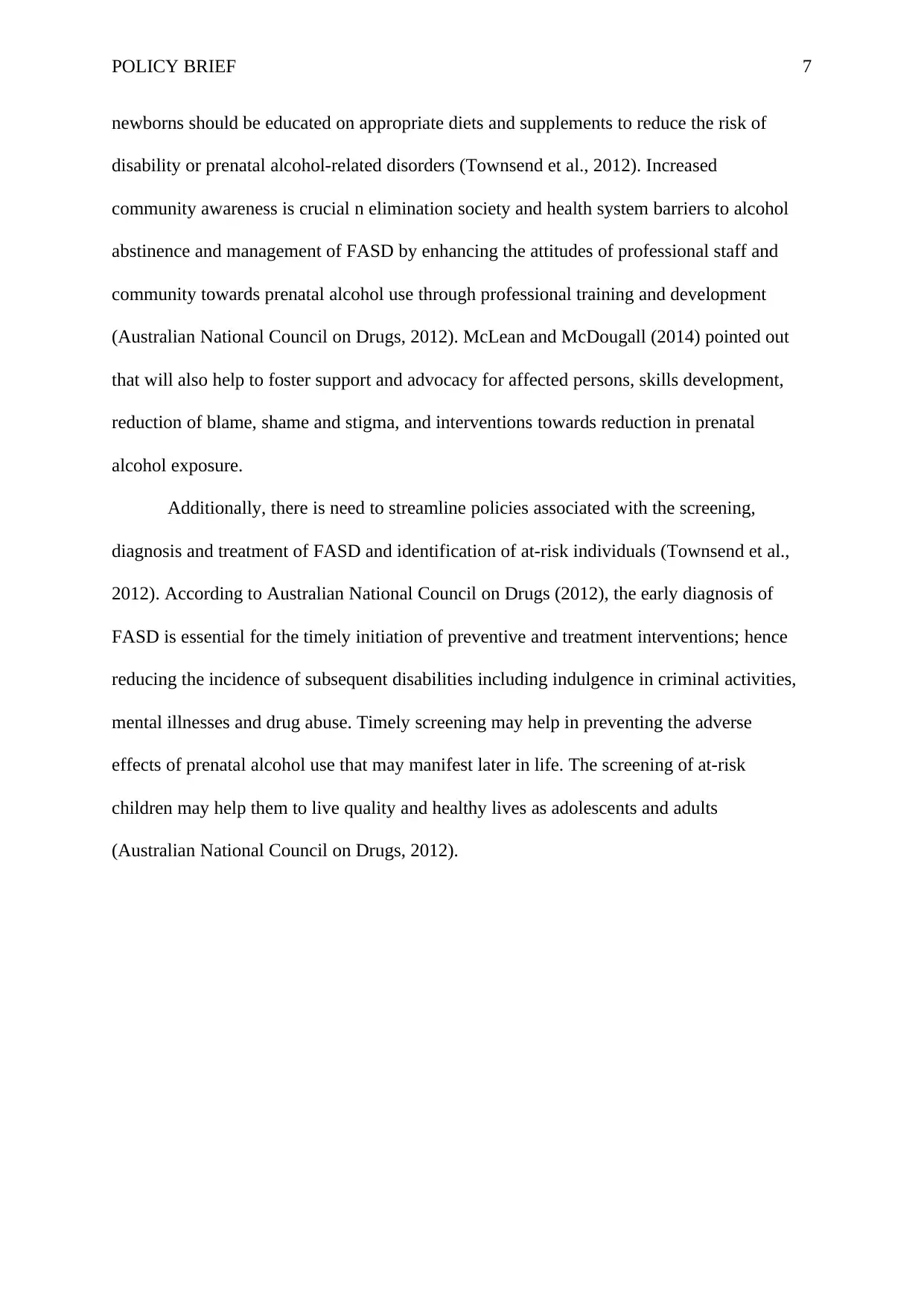
POLICY BRIEF 7
newborns should be educated on appropriate diets and supplements to reduce the risk of
disability or prenatal alcohol-related disorders (Townsend et al., 2012). Increased
community awareness is crucial n elimination society and health system barriers to alcohol
abstinence and management of FASD by enhancing the attitudes of professional staff and
community towards prenatal alcohol use through professional training and development
(Australian National Council on Drugs, 2012). McLean and McDougall (2014) pointed out
that will also help to foster support and advocacy for affected persons, skills development,
reduction of blame, shame and stigma, and interventions towards reduction in prenatal
alcohol exposure.
Additionally, there is need to streamline policies associated with the screening,
diagnosis and treatment of FASD and identification of at-risk individuals (Townsend et al.,
2012). According to Australian National Council on Drugs (2012), the early diagnosis of
FASD is essential for the timely initiation of preventive and treatment interventions; hence
reducing the incidence of subsequent disabilities including indulgence in criminal activities,
mental illnesses and drug abuse. Timely screening may help in preventing the adverse
effects of prenatal alcohol use that may manifest later in life. The screening of at-risk
children may help them to live quality and healthy lives as adolescents and adults
(Australian National Council on Drugs, 2012).
newborns should be educated on appropriate diets and supplements to reduce the risk of
disability or prenatal alcohol-related disorders (Townsend et al., 2012). Increased
community awareness is crucial n elimination society and health system barriers to alcohol
abstinence and management of FASD by enhancing the attitudes of professional staff and
community towards prenatal alcohol use through professional training and development
(Australian National Council on Drugs, 2012). McLean and McDougall (2014) pointed out
that will also help to foster support and advocacy for affected persons, skills development,
reduction of blame, shame and stigma, and interventions towards reduction in prenatal
alcohol exposure.
Additionally, there is need to streamline policies associated with the screening,
diagnosis and treatment of FASD and identification of at-risk individuals (Townsend et al.,
2012). According to Australian National Council on Drugs (2012), the early diagnosis of
FASD is essential for the timely initiation of preventive and treatment interventions; hence
reducing the incidence of subsequent disabilities including indulgence in criminal activities,
mental illnesses and drug abuse. Timely screening may help in preventing the adverse
effects of prenatal alcohol use that may manifest later in life. The screening of at-risk
children may help them to live quality and healthy lives as adolescents and adults
(Australian National Council on Drugs, 2012).
Paraphrase This Document
Need a fresh take? Get an instant paraphrase of this document with our AI Paraphraser
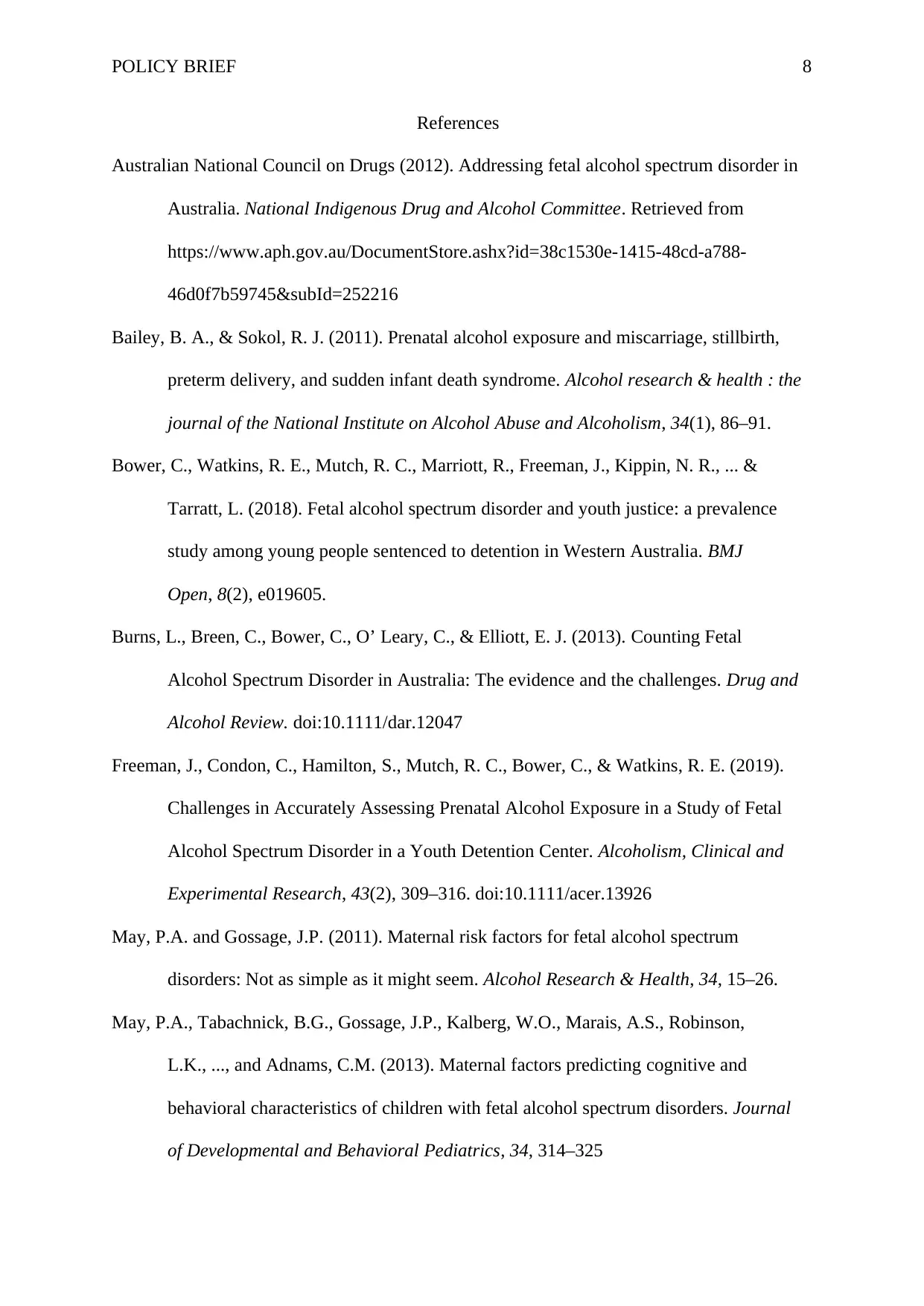
POLICY BRIEF 8
References
Australian National Council on Drugs (2012). Addressing fetal alcohol spectrum disorder in
Australia. National Indigenous Drug and Alcohol Committee. Retrieved from
https://www.aph.gov.au/DocumentStore.ashx?id=38c1530e-1415-48cd-a788-
46d0f7b59745&subId=252216
Bailey, B. A., & Sokol, R. J. (2011). Prenatal alcohol exposure and miscarriage, stillbirth,
preterm delivery, and sudden infant death syndrome. Alcohol research & health : the
journal of the National Institute on Alcohol Abuse and Alcoholism, 34(1), 86–91.
Bower, C., Watkins, R. E., Mutch, R. C., Marriott, R., Freeman, J., Kippin, N. R., ... &
Tarratt, L. (2018). Fetal alcohol spectrum disorder and youth justice: a prevalence
study among young people sentenced to detention in Western Australia. BMJ
Open, 8(2), e019605.
Burns, L., Breen, C., Bower, C., O’ Leary, C., & Elliott, E. J. (2013). Counting Fetal
Alcohol Spectrum Disorder in Australia: The evidence and the challenges. Drug and
Alcohol Review. doi:10.1111/dar.12047
Freeman, J., Condon, C., Hamilton, S., Mutch, R. C., Bower, C., & Watkins, R. E. (2019).
Challenges in Accurately Assessing Prenatal Alcohol Exposure in a Study of Fetal
Alcohol Spectrum Disorder in a Youth Detention Center. Alcoholism, Clinical and
Experimental Research, 43(2), 309–316. doi:10.1111/acer.13926
May, P.A. and Gossage, J.P. (2011). Maternal risk factors for fetal alcohol spectrum
disorders: Not as simple as it might seem. Alcohol Research & Health, 34, 15–26.
May, P.A., Tabachnick, B.G., Gossage, J.P., Kalberg, W.O., Marais, A.S., Robinson,
L.K., ..., and Adnams, C.M. (2013). Maternal factors predicting cognitive and
behavioral characteristics of children with fetal alcohol spectrum disorders. Journal
of Developmental and Behavioral Pediatrics, 34, 314–325
References
Australian National Council on Drugs (2012). Addressing fetal alcohol spectrum disorder in
Australia. National Indigenous Drug and Alcohol Committee. Retrieved from
https://www.aph.gov.au/DocumentStore.ashx?id=38c1530e-1415-48cd-a788-
46d0f7b59745&subId=252216
Bailey, B. A., & Sokol, R. J. (2011). Prenatal alcohol exposure and miscarriage, stillbirth,
preterm delivery, and sudden infant death syndrome. Alcohol research & health : the
journal of the National Institute on Alcohol Abuse and Alcoholism, 34(1), 86–91.
Bower, C., Watkins, R. E., Mutch, R. C., Marriott, R., Freeman, J., Kippin, N. R., ... &
Tarratt, L. (2018). Fetal alcohol spectrum disorder and youth justice: a prevalence
study among young people sentenced to detention in Western Australia. BMJ
Open, 8(2), e019605.
Burns, L., Breen, C., Bower, C., O’ Leary, C., & Elliott, E. J. (2013). Counting Fetal
Alcohol Spectrum Disorder in Australia: The evidence and the challenges. Drug and
Alcohol Review. doi:10.1111/dar.12047
Freeman, J., Condon, C., Hamilton, S., Mutch, R. C., Bower, C., & Watkins, R. E. (2019).
Challenges in Accurately Assessing Prenatal Alcohol Exposure in a Study of Fetal
Alcohol Spectrum Disorder in a Youth Detention Center. Alcoholism, Clinical and
Experimental Research, 43(2), 309–316. doi:10.1111/acer.13926
May, P.A. and Gossage, J.P. (2011). Maternal risk factors for fetal alcohol spectrum
disorders: Not as simple as it might seem. Alcohol Research & Health, 34, 15–26.
May, P.A., Tabachnick, B.G., Gossage, J.P., Kalberg, W.O., Marais, A.S., Robinson,
L.K., ..., and Adnams, C.M. (2013). Maternal factors predicting cognitive and
behavioral characteristics of children with fetal alcohol spectrum disorders. Journal
of Developmental and Behavioral Pediatrics, 34, 314–325
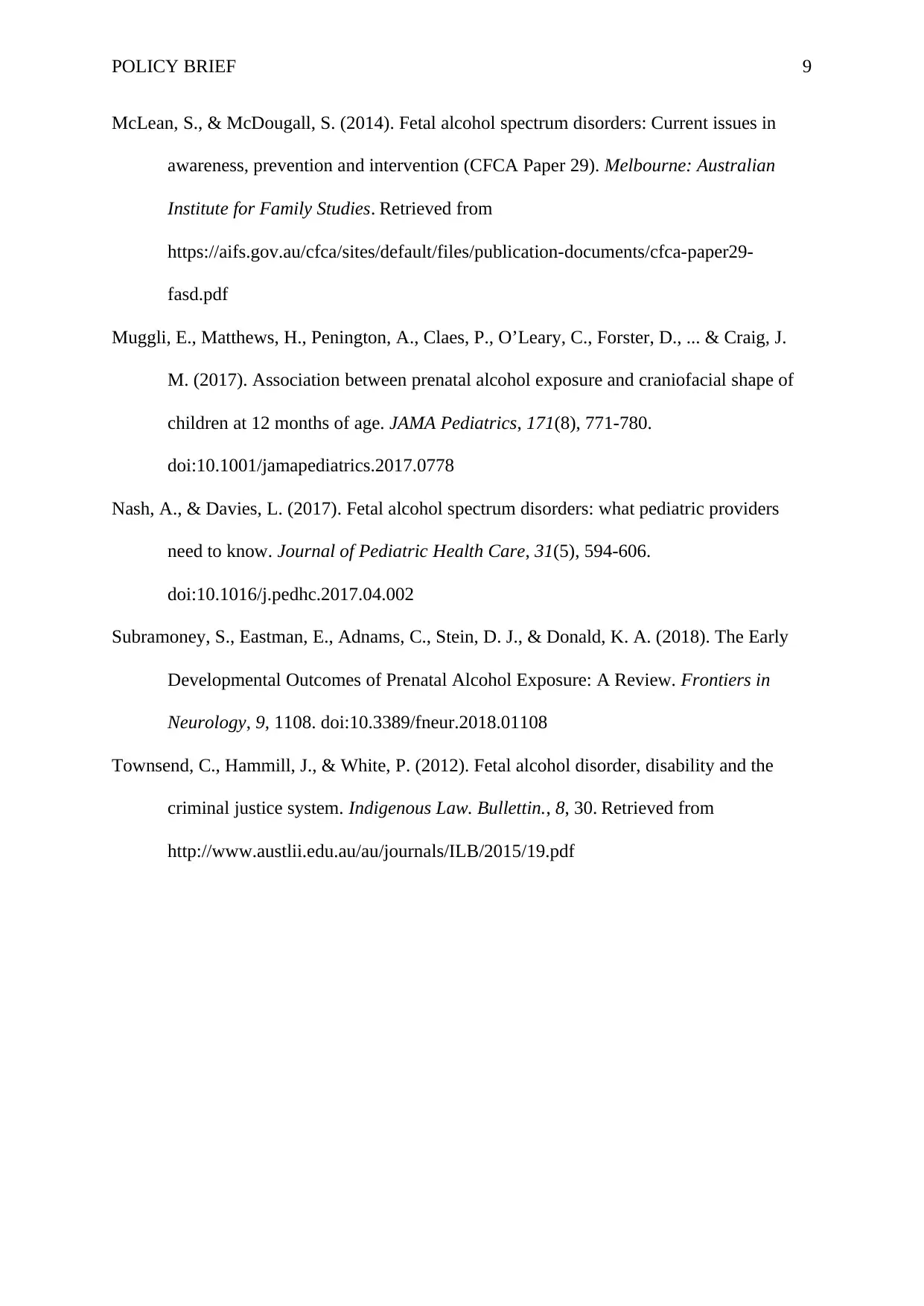
POLICY BRIEF 9
McLean, S., & McDougall, S. (2014). Fetal alcohol spectrum disorders: Current issues in
awareness, prevention and intervention (CFCA Paper 29). Melbourne: Australian
Institute for Family Studies. Retrieved from
https://aifs.gov.au/cfca/sites/default/files/publication-documents/cfca-paper29-
fasd.pdf
Muggli, E., Matthews, H., Penington, A., Claes, P., O’Leary, C., Forster, D., ... & Craig, J.
M. (2017). Association between prenatal alcohol exposure and craniofacial shape of
children at 12 months of age. JAMA Pediatrics, 171(8), 771-780.
doi:10.1001/jamapediatrics.2017.0778
Nash, A., & Davies, L. (2017). Fetal alcohol spectrum disorders: what pediatric providers
need to know. Journal of Pediatric Health Care, 31(5), 594-606.
doi:10.1016/j.pedhc.2017.04.002
Subramoney, S., Eastman, E., Adnams, C., Stein, D. J., & Donald, K. A. (2018). The Early
Developmental Outcomes of Prenatal Alcohol Exposure: A Review. Frontiers in
Neurology, 9, 1108. doi:10.3389/fneur.2018.01108
Townsend, C., Hammill, J., & White, P. (2012). Fetal alcohol disorder, disability and the
criminal justice system. Indigenous Law. Bullettin., 8, 30. Retrieved from
http://www.austlii.edu.au/au/journals/ILB/2015/19.pdf
McLean, S., & McDougall, S. (2014). Fetal alcohol spectrum disorders: Current issues in
awareness, prevention and intervention (CFCA Paper 29). Melbourne: Australian
Institute for Family Studies. Retrieved from
https://aifs.gov.au/cfca/sites/default/files/publication-documents/cfca-paper29-
fasd.pdf
Muggli, E., Matthews, H., Penington, A., Claes, P., O’Leary, C., Forster, D., ... & Craig, J.
M. (2017). Association between prenatal alcohol exposure and craniofacial shape of
children at 12 months of age. JAMA Pediatrics, 171(8), 771-780.
doi:10.1001/jamapediatrics.2017.0778
Nash, A., & Davies, L. (2017). Fetal alcohol spectrum disorders: what pediatric providers
need to know. Journal of Pediatric Health Care, 31(5), 594-606.
doi:10.1016/j.pedhc.2017.04.002
Subramoney, S., Eastman, E., Adnams, C., Stein, D. J., & Donald, K. A. (2018). The Early
Developmental Outcomes of Prenatal Alcohol Exposure: A Review. Frontiers in
Neurology, 9, 1108. doi:10.3389/fneur.2018.01108
Townsend, C., Hammill, J., & White, P. (2012). Fetal alcohol disorder, disability and the
criminal justice system. Indigenous Law. Bullettin., 8, 30. Retrieved from
http://www.austlii.edu.au/au/journals/ILB/2015/19.pdf
⊘ This is a preview!⊘
Do you want full access?
Subscribe today to unlock all pages.

Trusted by 1+ million students worldwide
1 out of 9
Your All-in-One AI-Powered Toolkit for Academic Success.
+13062052269
info@desklib.com
Available 24*7 on WhatsApp / Email
![[object Object]](/_next/static/media/star-bottom.7253800d.svg)
Unlock your academic potential
Copyright © 2020–2025 A2Z Services. All Rights Reserved. Developed and managed by ZUCOL.
